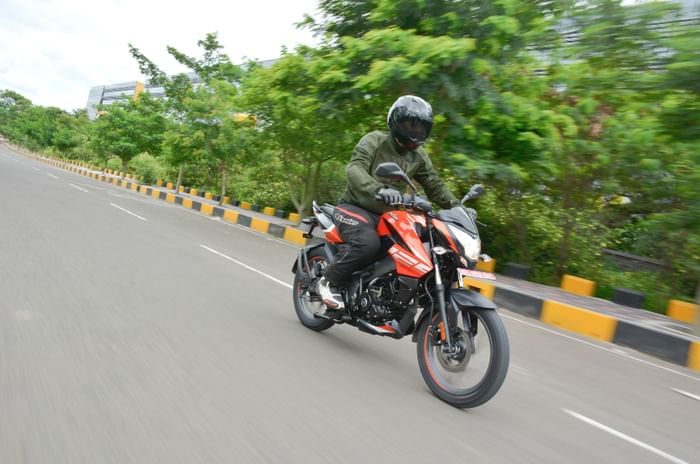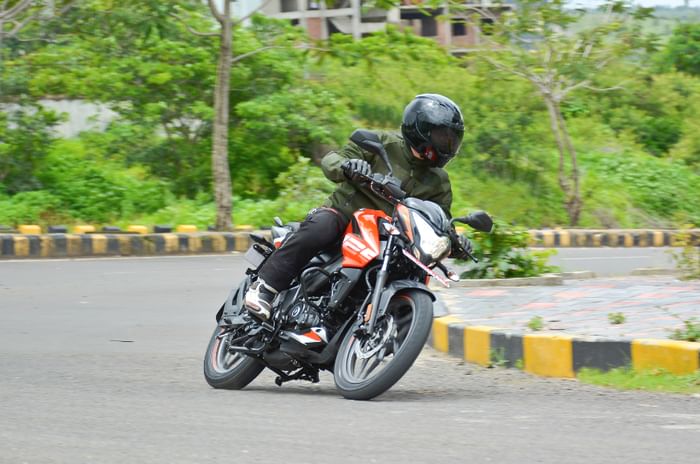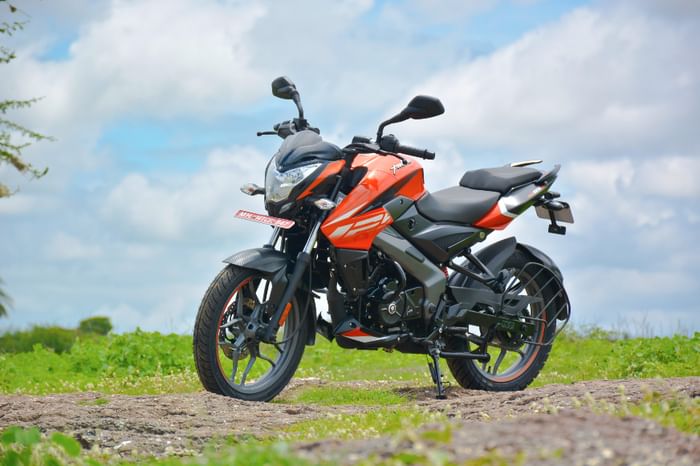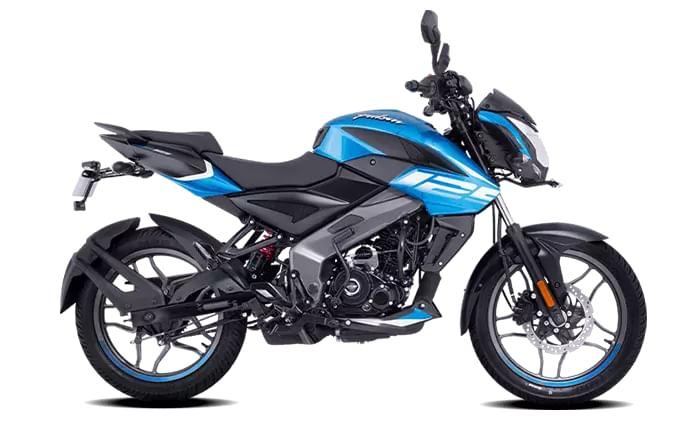Introduction Bajaj has taken its successful Pulsar NS formula and applied it to the 125cc segment, downsizing the engine from the regular Pulsar ...
Introduction
Bajaj has taken its successful Pulsar NS formula and applied it to the 125cc segment, downsizing the engine from the regular Pulsar NS160 and housing it in the perimeter frame from the bigger NS models. It sits somewhere between the true-blue commuters, and the sporty KTMs of the 125cc world, both in terms of specs as well as price. Can it amalgamate the riding thrills of the latter with the value-for-money of the former? Let's find out.
Design
You could pick up our 2012 issue, flip over to the review of the NS200, and know pretty much all there is to know about the NS125's design. That's because not only has the NS200 remained nearly identical over the last nine years, but the NS125 also looks almost like a twin to its larger sibling, save for a smaller engine, skinner tyres, a more slender (but still box-section) swingarm and different graphics.
Perhaps the biggest praise of this design is the fact that it remains pleasing to the eye even today. Aside from the KTM pair (which cost a good 75 percent more than this little NS), nothing else in the 125cc class looks as special or as sporty. The youthful face created by the single headlight and twin pilot lamps is still fresh, as are the Pulsar-typical twin vertical strips that function as brake lamps. Overall, the NS125 gets a handsome streetfighter look, without anything overly muscular or flamboyant.
For what it’s worth, the updated graphics schemes have done their part in helping the NS series mask its age, and that continues with this 125cc iteration too. Though we are glad that Bajaj gave the white frame and wheels a miss on this smaller version. The design of the wheels is one of the highlights of the NS’ look, along with a neat tail section. If we had to nitpick, the skinner tyres do look slightly disproportionate to the rest of the motorcycle, but it’s certainly no deal-breaker.
Quality levels are a marked step-up over something like the Pulsar 125, with decent fit and finish, and tight panel gaps across the NS125. That being said, the one area of the bike that really feels dated after all these years is instrumentation. Like its design, the NS125 borrows its semi-digital instrumentation from the NS200, meaning an analogue tachometer (which is nice) and digital speedometer, but no information about gear position or fuel consumption (which is not so nice).
Along with the displays, the switchgear could also do with an update.
Performance
The engine is a rather basic unit on paper. It’s a four-valve air-cooled motor and one that’s a bit of an anomaly in the BS6 era because it doesn’t feature fuel-injection. Instead, it employs Bajaj’s unique e-carb technology. The final result is output figures of 12hp at 8,500rpm and 11Nm at 7,000rpm. For reference, this is slightly higher than the regular Pulsar 125’s figures of 11.8hp and 10.8Nm, but still slightly off the KTM pair’s output of 15hp and 12Nm. In the real world, though, the NS125 feels sprightly enough.

The motor is tractable right off idle, making it rather usable in the city. From there on, power builds nicely up to around 9,000rpm, beyond which it neither pulls very hard nor sounds very pleasant. Nevertheless, up to that point, there’s a fair amount of pulling power available, keeping the displacement figure in mind. It’s only once you approach the triple-digit mark that the NS begins to feel stretched. The data backs this up, because the bike gets to 80kph in a respectable 10.52sec, but then requires another 13 seconds to make it to the 100kph mark! With patience and a light enough rider, you’ll get close to the limiter in top gear and see as high as 115kph on the speedometer, by which point the engine feels and sounds terribly unhappy with what you’re asking of it.
Clutch feel is light and natural, and gear ratios are well chosen, but there’s no getting around the fact that there are only five of them available. They’re tall enough that gear changes aren’t frustratingly frequent in the city, yet short enough that the NS accelerates reasonably quickly and feels nicely tractable at urban speeds. What they can’t provide, though, is a relaxed highway cruising experience. The motor’s harsh top-end, combined with the absence of a sixth cog, means that you’ll want to cap your cruising speeds at about 80 to 85kph, lack of pulling power notwithstanding.
Another by-product of this phenomenon is the slightly low highway fuel efficiency. Having to sit at high RPMs means the motor empties its fuel tank quicker, returning only just over 50kpl on the highway. Things are a lot better in the city, where the NS125 delivers a near-60kpl efficiency figure that’s more in-line with its displacement. With a 12-litre fuel tank, you’re still looking at a good 500km of highway use before alarm bells start going off, and the NS should comfortably have you covered for a week of commuting on each fill-up.
As for that e-carb technology, its biggest praise is that you can barely feel it’s there. For all intents and purposes, the NS125 feels like a fuel-injected motorcycle, and the only sign that there’s anything out of the ordinary, is the motor cranking for slightly longer than usual during cold starts.
Ride & Handling
Where the Pulsar NS125 falls short in brochure-filling features, it makes up in competent underpinnings. At under Rs 1 lakh (ex-showroom, Delhi), Bajaj is giving you respectable hardware in the form of a perimeter frame and a preload-adjustable monoshock, just like on the larger NS models. As a result, handling is rather sweet, and the NS is a fun bike to throw around corners. The skinny tyres might not do much for the looks, but they make the NS125 feel lighter on its feet than the slightly heavy-steering NS200. Sure, it isn’t the most communicative thoroughbred corner-carver, but once tipped in with minimal effort, the bike feels steady enough and inspires a fair amount of confidence.

That’s the sportiness side taken care of. The sensibility aspect comes from the good ride quality and large dimensions. The telescopic fork does a great job of isolating you from our less-than-perfect roads, though the monoshock can feel a little on the firmer side, even at its lower preload settings. Nevertheless, ride quality overall is quite comfortable, as is the seating position.
Sharing its underpinnings with the NS200 not only gives the 125 fun handling characteristics, but also generous proportions that are well suited to similarly generously proportioned riders. The 1,353mm wheelbase is longer than even that of the Pulsar 150, and taller riders will find the rider’s triangle pleasantly roomy, with a good reach to the bars and enough seat-to-footpeg distance. The only real chink in the NS’ armour in the comfort department is a seat that can become slightly uncomfortable over longer durations –an issue that’s amplified by the slightly stiff rear shock absorber.
At 144kg, the NS125 is a good 20 to 30kg heavier than traditional 125cc commuters, but a well-balanced chassis means that you don’t really feel this once you’re on the move. Even at a standstill, the weight is quite manageable, and it’s only 4kg heavier than the standard Pulsar 125, which is commendable. Lighter cycle parts and a smaller, lighter engine also mean that it’s 7kg lighter than the NS160 and 12kg lighter than the NS200.
The theme of middle ground extends to seat height as well, where the Pulsar’s 810mm figure lies almost exactly in between commuters like the Honda Shine (791mm) and more focused bikes like the KTM 125 Duke (830mm).
The NS’ performance in the ‘stop’ department is similar to its performance in the ‘go’ department. On paper, it only gets a small 240mm disc brake up front. There’s no disc of any kind at the rear, and you have to make do with a 130mm drum brake instead. Nevertheless, the real-world performance is up to the mark, and the setup does a decent job of bringing the bike to a stop. The only room for improvement is a little more feel at the lever, and the addition of an ABS system –although Bajaj would point out that that would take the price well above the Rs 1 lakh mark, which has significant psychological ramifications for a 125cc motorcycle.
Verdict

The final piece of the puzzle is the price tag. The exact amount is Rs 98,234 (ex-showroom, Delhi), which places it almost exactly on par with the Pulsar 150 Neon. For reference, it’s about Rs 20,000 more expensive than the regular Pulsar 125, while the KTM 125 Duke is a whole Rs 72,000 more than the NS125. With this context in mind, the Pulsar NS125 certainly carries a premium price, but it also delivers a distinct and unique experience in the 125cc segment, one with a strong Pulsar flavour to it. It has superior dynamics to both, the Pulsar 125 and the Pulsar 150 Neon and it also looks and feels a whole lot more modern than those two. All this while remaining considerably more affordable than its Austrian counterparts. It seems that Bajaj has found an enticing middle ground, and by doing so, the company is further exploring uncharted territory in the 125cc segment.
 Bajaj Pulsar NS125
Bajaj Pulsar NS125 Honda Bikes Unicorn
Honda Bikes Unicorn  Honda Bikes SP 125
Honda Bikes SP 125  TVS Apache RTR 160 4V
TVS Apache RTR 160 4V  Yamaha FZ S FI
Yamaha FZ S FI  Bajaj Pulsar NS160
Bajaj Pulsar NS160  Bajaj Pulsar 125
Bajaj Pulsar 125  Bajaj Pulsar 150
Bajaj Pulsar 150 
